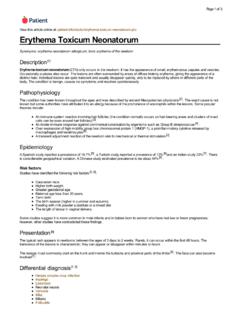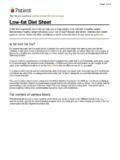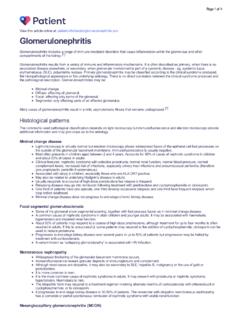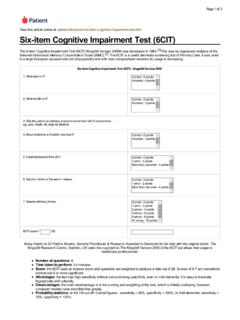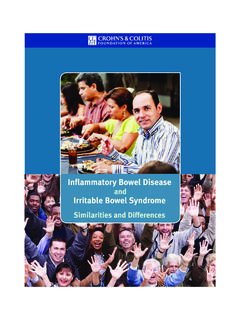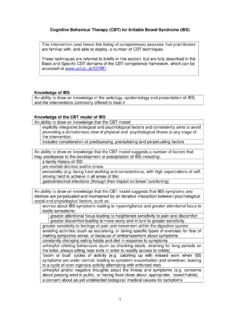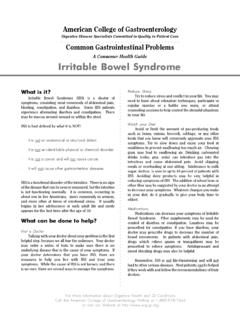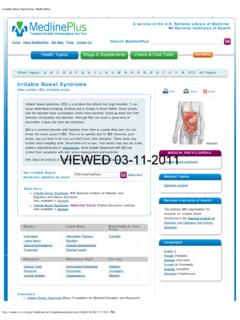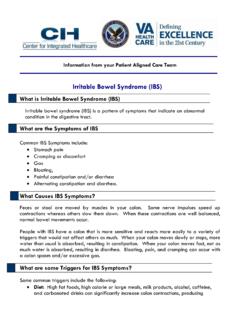Transcription of Irritable Bowel Syndrome Diet Sheet - m.patient.media
1 Page 1 of 6. View this article online at: Irritable Bowel Syndrome diet Sheet Irritable Bowel Syndrome (IBS) is a common gut disorder. The cause is not known. Symptoms can be quite variable and include tummy (abdominal) pain, bloating and sometimes bouts of diarrhoea and/or constipation. Symptoms tend to come and go. There is no cure for IBS but symptoms can often be eased with treatment. It's unclear what exactly causes IBS in adults; various factors are involved. These include sensitivity of the gut, inflammation of the lining in the digestive tract and disturbance of movements in the bowels. Many of those who have the condition report that making dietary changes can help them to manage their IBS, ease symptoms and improve quality of life. diet and lifestyle changes for treatment of IBS. diet and lifestyle management can be used as a treatment for Irritable Bowel Syndrome (IBS).
2 When looking to treat symptoms of IBS, using a staged approach is most useful. It may be as simple as eating healthily and changing lifestyle factors, or there may be slightly stricter and more specific ways to manage symptoms. Before making any dietary changes, keep a food and symptom diary for a week. This can be a helpful way to identify foods that may be triggering a response in your body. Record all food and drink consumed for a week and make a note of any symptoms experienced. Try to record an approximate quantity eaten and the time of day. Symptoms may not always be caused by what you eat so consider other factors that may be involved. Step one - healthy eating and lifestyle changes A healthy diet This includes: Plenty of fruit and vegetables. Plenty of starchy carbohydrates. Examples include bread, rice, cereals, pasta, potatoes, chapattis and plantain. Some milk and dairy products (2-3 portions per day).
3 If you are lactose intolerant include dairy alternatives such as soya, rice or oat milk and yoghurts that are enriched with calcium. Some protein foods: meat, fish, eggs and alternatives such as beans and pulses. Limited amounts of foods high in fats and sugars. Limit saturated fat that is found in animal products such as butter, ghee, cheese, meat, cakes, biscuits and pastries. Replace these with unsaturated fats found in vegetable oils such as sunflower, rapeseed and olive oil, avocados, nuts and seeds. Drink plenty of fluid - at least two litres daily, such as water or herbal teas. Lifestyle changes to improve symptoms Have a regular meal pattern. Take time when eating meals. Try not to skip meals. Sit down to eat; chew food well. Try to avoid eating too late at night. Exercise regularly, such as walking, cycling, or swimming. If finding time is difficult, incorporate it into your day.
4 For example, cycle to work, get off a train a stop early and walk, and use steps instead of lifts when possible. Page 2 of 6. De-stress If you have a hectic lifestyle, stress and anxiety may also be causing IBS symptoms. There are many complex connections between the brain and the gut. Psychological factors, the nervous system, and muscle contractions in the gut all interact with each other, causing IBS symptoms. This is known as the brain-gut axis. Therefore, stress management can be effective in easing symptoms. Create time for relaxation. Make the most out of leisure time. Try relaxation therapies such as mindfulness. Exercise - try yoga or taking a walk. Get enough sleep. Seek support or counselling. Step two - symptom-specific changes to the diet Sometimes, a healthy balanced diet and lifestyle changes aren't enough to improve symptoms. It may be that more specific changes to the diet are needed.
5 Many people report that what they eat affects their symptoms. Therefore, modifying what you eat can help to manage symptoms. Reduce caffeine Caffeine can stimulate activity in the colon, which may worsen symptoms of pain and diarrhoea. Limit tea and coffee to no more than three cups per day. Filter coffee contains higher amounts of caffeine (140 mg) compared to instant coffee (100 mg) and tea (75 mg). So, if filter coffee is included in your diet , you may want to limit this to two cups per day. There is also caffeine in cola and some other soft drinks, and in chocolate. Limit alcohol and fizzy drinks Fizzy drinks and alcohol can worsen symptoms of diarrhoea. Limit your intake of these drinks to improve symptoms. Aim to have at least two alcohol-free days each week and no more than two units each day. A unit of alcohol is: One 25 ml shot of spirits. Half a pint of standard-strength lager/beer (3-4% alcohol by volume).
6 One small 125 ml glass of wine (11% alcohol by volume). Reduce intake of resistant starches These are starches that are resistant to digestion in the gut (small intestine). Therefore, they reach the colon intact and are fermented by the germs (bacteria) in our gut. This produces gases and waste products, leading to symptoms of, bloating, wind and diarrhoea. People who have IBS react to smaller doses of resistant starches than those who don't have IBS. Reducing resistant starches may also improve symptoms of diarrhoea. Reduce intake of foods containing resistant starches Processed foods such as crisps, oven chips, supermarket pizza, biscuits and cakes, breakfast cereals. Foods that have been cooked and left out to cool - for example, cold potato/pasta salads. Ready meals. Partially baked bread - for example, garlic bread or pizza bases. Whole grains, pulses, sweetcorn, green banana and muesli that contains bran.
7 Dried pasta (use fresh instead). Pastry. Savoury snacks. Cook fresh food whenever possible and eat food that you've cooked straightaway. This will help to reduce intake of resistant starches. Page 3 of 6. Modify your fibre intake Fibre can be a confusing subject for many of those affected by IBS. For some people, reducing high-fibre foods can help to improve symptoms. For others, increasing fibre can help to improve symptoms, so it is very much dependent on the individual. Adjust fibre intake according to personal symptoms. Use a food and symptom diary and monitor any changes. It may help to clarify what exactly dietary fibre is and how it may affect symptoms. There are two types of fibre which work differently in the body. Generally, reducing insoluble fibre may help with symptoms but if an increase in fibre is necessary, this should be from soluble fibre. Insoluble fibre This type of fibre does not dissolve in water and is not readily broken down, so it passes through the digestive system mostly intact.
8 It absorbs water, adds bulk to stools (faeces) and allows waste to be passed through bowels more quickly. Reducing this type of fibre may help to improve symptoms of diarrhoea. Foods to reduce or avoid: Skin, pith and pips of fruit and vegetables. Wheat and bran. Corn (maize). Nuts and whole grains. Soluble fibre This type of fibre dissolves in water and is broken down by the natural bacteria in the bowels. It softens stools and makes them larger. Increasing this type of fibre may help to improve symptoms of constipation. Foods to include are: Oats Barley Psyllium and ispaghula Nuts and seeds Fruit and vegetables Beans and pulses Whole grains (for example, wholemeal bread, brown rice and wholewheat pasta) may also help with constipation. Although increasing fibre may help to improve symptoms, it may also generate gas and cause pain and bloating. Monitoring is important to help identify this and to adjust your fibre intake according to your symptoms.
9 If fibre intake is suddenly increased, this can cause symptoms of wind and bloating. Introduce high-fibre foods gradually to allow the gut to become used to the extra fibre. Introduce one new food over a two- to three-day period and monitor any symptoms. For example, have porridge for breakfast on the first day; then add beans or extra vegetables to a casserole two days later; then maybe have an extra piece of fruit two to three days later. Drink plenty Fibre needs water, so aim to drink at least 8-10 cups of water daily or other fluids such as herbal teas or sugar- free squash. People with diarrhoea will need to make sure they are replacing these lost fluids. Drinking water will also help to improve constipation. Include golden linseeds Including these in the diet may improve symptoms of wind, bloating, constipation and diarrhoea. They are a source of insoluble and soluble fibre.
10 They can be added to casseroles, stews, soups, porridge, cereals, yoghurts and desserts. Include one tablespoon each day. Reduce fatty foods Some people find that fatty foods are difficult to digest and can cause symptoms of diarrhoea; therefore, reducing fat in the diet may help: Limit cakes, biscuits, chocolates and pastries. Cut down on fatty meat products such as sausages, pies and pasties. Page 4 of 6. Use lower-fat dairy products - for example, low-fat yoghurt, cottage cheese, semi-skimmed milk. Choose tomato-based sauces rather than creamy sauces - although some tomato sauces can be oily so check the label. Use small amounts of cheese (a matchbox size is a portion) - stronger-flavoured cheeses may help you to use less. Take care when using dressings and sauces such as mayonnaise and salad cream. Use small amounts and try the reduced-fat versions. Cut off visible fat from meat and choose leaner cuts of meat.
